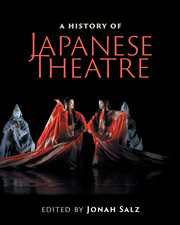Book contents
- Frontmatter
- Contents
- List of figures
- List of tables
- Contributors
- Contributors’ biographies
- Foreword
- Acknowledgments
- Note on Japanese terms
- List of abbreviations
- Timeline
- Editor's introduction
- I Traditional theatres
- Preface to Part I Japanese civilization arises
- 1 Ancient and early medieval performing arts
- Interlude Katari narrative traditions: from storytelling to theatre
- 2 Noh and Muromachi culture
- Interlude Noh and kyogen costumes and masks
- 3 Kyogen: classical comedy
- Interlude Iemoto : the family head system
- 4 Kabuki: superheroes and femmes fatales
- Interlude Nihonbuyo: classical dance
- Interlude Okinawan theatre: boundary of Japanese theatre
- 5 Bunraku: puppet theatre
- Interlude Misemono and rakugo : sideshows and storytelling
- Interlude Kamigata geinō : Kyoto-Osaka style
- Interlude Traditional theatre tomorrow: interview with Takemoto Mikio
- II Modern theatres
- Preface to Part II
- III Arcs and patterns
- IV Theatre architecture
- Preface to Part IV Evolution of Japanese theatre architecture
- V Theatre criticism
- VI Intercultural influences
- Epilogue: Frozen words and mythology
- Further reading
- Index
- References
Interlude Iemoto : the family head system
from Preface to Part I Japanese civilization arises
Published online by Cambridge University Press: 05 July 2016
- Frontmatter
- Contents
- List of figures
- List of tables
- Contributors
- Contributors’ biographies
- Foreword
- Acknowledgments
- Note on Japanese terms
- List of abbreviations
- Timeline
- Editor's introduction
- I Traditional theatres
- Preface to Part I Japanese civilization arises
- 1 Ancient and early medieval performing arts
- Interlude Katari narrative traditions: from storytelling to theatre
- 2 Noh and Muromachi culture
- Interlude Noh and kyogen costumes and masks
- 3 Kyogen: classical comedy
- Interlude Iemoto : the family head system
- 4 Kabuki: superheroes and femmes fatales
- Interlude Nihonbuyo: classical dance
- Interlude Okinawan theatre: boundary of Japanese theatre
- 5 Bunraku: puppet theatre
- Interlude Misemono and rakugo : sideshows and storytelling
- Interlude Kamigata geinō : Kyoto-Osaka style
- Interlude Traditional theatre tomorrow: interview with Takemoto Mikio
- II Modern theatres
- Preface to Part II
- III Arcs and patterns
- IV Theatre architecture
- Preface to Part IV Evolution of Japanese theatre architecture
- V Theatre criticism
- VI Intercultural influences
- Epilogue: Frozen words and mythology
- Further reading
- Index
- References
Summary
The development of the iemoto (family head, 家元) system shaped the history of many traditional Japanese performing arts and continues to have a weighty influence on training, repertoire, and staging in noh and kyogen, nihonbuyo (classical Japanese dance), and kabuki musicians. Additionally, the iemoto system offers a point of commonality between traditional drama and other arts, such as tea ceremony, flower arrangement, and martial arts’ organizational structures. Conversely, the lack of an iemoto distinguishes kabuki from noh and kyogen, although several kabuki actors head schools of classical Japanese dance. As scholar Nishiyama Matsunosuke has explored, familiarity with iemoto and their institutional powers, which comprise an “iemoto system,” sheds light on continuities across traditional arts.
Though translated as “family,” ie also means “lineage and household,” and usage, especially before World War II, “evokes the image of an absolute and often arbitrarily exercised patriarchal authority.” The authority of the iemoto (also referred to as the sōke, 宗家) derives from being the primary successor by birth, adoption, or marriage to a family controlling an artistic dynasty with a distinct style (school or ryūgi, 流儀) of performance established by the family's founder.
Noh provides an example of one of the most orthodox and powerful iemoto systems of all Japanese arts. Kanze Kiyokazu (1959–), current iemoto of the Kanze school, is the twenty-sixth hereditary leader, tracing his ancestry to Zeami (1363?–1443?) and his father Kan'ami (1333–84). Kiyokazu's position gives him power over professionals and amateurs in the Kanze school. Familial authority not only makes the iemoto synonymous with his artistic lineage, but also grants him a direct line to the highest and most complete expertise of his specialty, whether found in secret manuscripts transmitted in his family or received in specialized training from the best teachers, including the previous iemoto. The depth of iemoto expertise is exemplified by the expression “isshi sōden” (exclusively transmitted to one child), referring to knowledge so secret that only one person per generation is entitled to receive it.
Use of the word iemoto in relation to performing arts dates to the mid-eighteenth century but, from at least Zeami's era, leaders of noh troupes (za) jealously guarded secrets of their craft.
- Type
- Chapter
- Information
- A History of Japanese Theatre , pp. 99 - 101Publisher: Cambridge University PressPrint publication year: 2016



